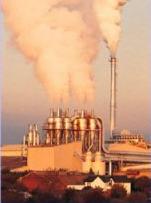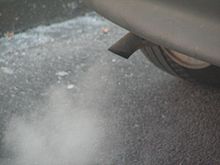Exhaust gas: Difference between revisions
| Line 20: | Line 20: | ||
===Gas-turbine engines=== |
===Gas-turbine engines=== |
||
*In aircraft gas turbine engines, "exhaust gas temperature" (EGT) is a primary measure of engine health. Typically the EGT is compared with with a primary engine power indication called "engine pressure ratio" (EPR). For example: at full power EPR there will be a maximum permitted EGT limit. Once an engine reaches a stage in its life where it reaches this EGT limit, the engine will require specific maintenance in order to recifify the problem. The amount the EGT is below the EGT limit is called EGT margin. The EGT margin of an engine will be greatest when the engine is new, or has been overhauled. |
|||
===Jet engines and rocket engines=== |
===Jet engines and rocket engines=== |
||
Revision as of 14:03, 12 July 2009

Exhaust gas or flue gas is emitted as a result of the combustion of fuels such as natural gas, gasoline/petrol, diesel, fuel oil or coal. It is discharged into the atmosphere through an exhaust pipe, flue gas stack or propelling nozzle.
It often disperses downwind in a pattern called an exhaust plume.
Composition
Although the largest part of most combustion gases is relatively harmless nitrogen (N2), water vapor (H2O) (except with pure-carbon fuels), and carbon dioxide (CO2) (except with hydrogen as fuel), a relatively small part of it is undesirable noxious or toxic substances, such as carbon monoxide (CO), hydrocarbons, nitrogen oxides (NOx), partly unburnt fuel, and particulate matter.

Types
Spark-ignition engines
In spark-ignition engines exhaust gas from an internal combustion engine whose fuel includes nitromethane, contains nitric acid vapour, which when inhaled causes a muscular reaction making it impossible to breathe, and people exposed to it should wear a gas mask.[1]
Diesel engines
In diesel engines, conditions in the engine are different from in a spark-ignition engine, because power is controlled by controlling the fuel supply directly, not by controlling the air supply. As a result, when the engine is running at low power, there is enough oxygen present to burn the fuel, and diesel engines only make significant amounts of carbon monoxide when running under load. Diesel exhaust is well known for its characteristic smell; but in Britain this smell in recent years has become much less (while diesel fuel getting more expensive) because the sulfur is now removed from the fuel in the oil refinery. Diesel combustion exhaust is a major source of atmospheric soot, fine particles, and nanoparticles.
Gas-turbine engines
- In aircraft gas turbine engines, "exhaust gas temperature" (EGT) is a primary measure of engine health. Typically the EGT is compared with with a primary engine power indication called "engine pressure ratio" (EPR). For example: at full power EPR there will be a maximum permitted EGT limit. Once an engine reaches a stage in its life where it reaches this EGT limit, the engine will require specific maintenance in order to recifify the problem. The amount the EGT is below the EGT limit is called EGT margin. The EGT margin of an engine will be greatest when the engine is new, or has been overhauled.
Jet engines and rocket engines
In jet engines and rocket engines, exhaust from propelling nozzles which in some applications shows shock diamonds.[citation needed]
From burning coal
Steam engines
In steam engine terminology the exhaust is steam that is now so low in pressure that it can no longer do useful work.
Others
Pollution reduction
Emission standards focus on reducing pollutants contained in the exhaust gases from vehicles as well as from industrial flue gas stacks and other air pollution exhaust sources in various large-scale industrial facilities such as petroleum refineries, natural gas processing plants, petrochemical plants and chemical production plants.[1][2]
One of the advantages claimed for advanced steam technology engines is that that they produce smaller quantities of toxic pollutants (e.g. oxides of nitrogen) than petrol and diesel engines of the same power.[citation needed] However, there is a downside – they produce larger quantities of carbon dioxide.
See also

- Alternative propulsion
- Atmospheric dispersion modeling
- Catalytic converter
- Clean Air Act
- Combustion
- Emission standards
- Emission test cycle
- Fly ash
- Global warming
- Greenhouse gas
- Kyoto protocol
References
- ^ EPA Plain English Guide to the Clean Air Act
- ^ US EPA Publication AP 42, Fifth Edition, Compilation of Air Pollutant Emission Factors
External links
- Health and Air Pollution Publication of the California Air Resources Board
- About diesel exhaust:
- U.S. Department of Labor Occupational Safety & Health Administration: Safety and Health Topics: Diesel Exhaust
- Partial List of Chemicals Associated with Diesel Exhaust
- Diesel Exhaust Particulates: Reasonably Anticipated to Be A Human Carcinogen
- Scientific Study of Harmful Effects of Diesel Exhaust: Acute Inflammatory Responses in the Airways and Peripheral Blood After Short-Term Exposure to Diesel Exhaust in Healthy Human Volunteers
- Diesel exhaust: what you need to know
